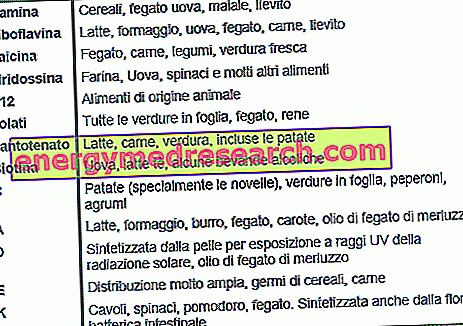Key points
The term torticollis refers to a vicious inclination of the head on the neck, always involuntary and with sudden and painful onset. In other words, the torticollis is a transitory "deformity" of the cervical tract which is characterized by the anomalous position assumed by the head after an imperfect or abrupt rotation of the neck.

variants
- Muscular / osteoarticular torticollis can be the consequence of cold strokes, viral infections, tuberculosis, arthritis, arthrosis and rheumatism;
- The symptomatic stiff neck may depend on neuralgia, paralysis, otitis, thyroid disorders, strabismus, migraine, convulsive fever;
- Congenital torticollis is a pathology due to malformative diseases originating during intrauterine life.
Diagnosis
In the event of a stiff neck, it is necessary to undergo diagnostic tests (usually radiographic) to exclude any serious traumatic injuries.
Therapy
Treatment for torticollis depends on the cause that originated it. Oral administration of NSAIDs or muscle relaxants, possibly accompanied by the infiltration of analgesics in the myalgic spots, can bring relief. Sometimes the use of an orthopedic collar is recommended.
Definition of stiff neck
Medicine, the term "stiff neck" defines an imperfect inclination of the head on the neck, always involuntary and permanent, with sudden and painful onset. In current language, torticollis is considered to be an acute and painful block of the neck that typically occurs during a sharp rotation or sudden flexion of the cervical spine. Neck pain generally extends over a period of time ranging from a few days to a couple of weeks. The stiff neck is therefore a deformity of the cervical tract which is characterized by the anomalous position assumed by the head after a rotation of the neck.
The most common variant of all is the muscular torticollis, a spastic and extremely painful contraction of the neck muscles, typical of youth. There is also the traumatic form of torticollis, which occurs after an accident or a fall. The symptomatic torticollis, on the other hand, recognizes various causes of origin (eg altered vision, neurological pathologies, etc.). Lastly - but not least - we recall the congenital torticollis, caused by a retraction of the sternocleidomastoid muscle or by bone malformations of the cervical vertebrae.
Muscular stiff neck / osteoarticular
Muscular / osteoarticular torticollis is often caused by a strong contraction of the sternocleidomastoid, splenium and levator scapulae ( levator scapulae) muscles.
Besides these factors, further and possible defendants of muscular torticollis are:
- Cold spells and drafts
- Viral infections (eg supported by West Nile virus)
- Tuberculosis
- Arthritis and arthrosis
- Rheumatism
In the event of a muscular stiff neck, palpation of the neck is very painful. The standard treatment for the muscle variant involves the use of an orthopedic collar, possibly associated with drug therapy with NSAIDs (non-steroidal anti-inflammatory drugs), muscle relaxants or corticosteroids. Sometimes, even the penetration of analgesics into painful (mialgic) muscle points can bring rapid, albeit temporary, relief. Some patients suffering from torticollis find benefit through acupuncture or targeted physiotherapy massages (performed by expert and qualified personnel).
Stiff neck "DDIM"
The abbreviation "DDIM" stands for "minor intervertebral pain disorder". Similar to the muscle variant, the DDIM torticollis is quite common and causes a myalgic reaction with possible extreme sharpening points ( trigger points).
More often, the DDIM torticollis is caused by a rapid twisting movement of the neck, sometimes just mentioned. This form of torticollis often involves the cervical area between the C2 and C3 vertebrae.
The torticollis from DDIM must be differentiated from a severe traumatic cervical lesion. For this purpose, the patient must undergo radiographic tests to ascertain the source of the pain.
The ideal treatment for DDIM stiff neck pain is the use of an orthopedic collar, accompanied by specific relaxation maneuvers performed by a competent healthcare figure.
In the acute torticollis - whether it is of muscular origin or DDIM - the neck is blocked in lateral inclination, and every slightest movement generates a sharp, penetrating and unbearable pain. The "block" of the neck normally affects only one side, or rotation is allowed on one side but denied on the other. However, in some patients, the movement of the neck is prevented on both sides.
The differential diagnosis between muscular torticollis and DDIM torticollis is important, but not always so immediate. In general, when manipulation is possible (but always extremely painful), and subsequently causes immediate relief, it is more likely that you are facing a DDIM stiff neck.
Symptomatic stiff neck
The symptomatic stiff neck is an acquired stiff neck of various origins, therefore dependent on several different causes:
- Neuralgia: radiculitis, neuritis
- Lesions of the extrapyramidal system (group of nerve pathways and centers that act at the level of the motor sphere)
- Psychotic or epileptic spasms
- Central or peripheral paralysis
- Otitis media, possibly associated with mastoiditis or labyrinthitis (internal otitis), responsible for otogenic torticollis
- Thyroid diseases (eg voluminous goiter)
- Rhino-pharyngeal diseases
- Strabismus or astigmatism, responsible for ocular torticollis. In this case, the stiff neck is due to an imperfect attitude taken by the head of the patient suffering from vision pathologies, in an attempt to "correct" the visual defect
- Severe migraine
- Convulsive fever
The therapy is symptomatic, therefore it must be established according to the triggering cause. If the pharmacological treatments are unsuccessful, we proceed with a surgical intervention.
Congenital torticollis
This variant of torticollis is a pathology due to malformative diseases, originating during the intrauterine life. In turn, the congenital torticollis is distinguished in:
- MIOGEN CONGENITAL TORCICOLLO : this is the most frequent variant of congenital torticollis, due essentially to the retraction of the sternocleidomastoid muscle. Patients affected by myogenic torticollis have an evident lateral inclination of the head, associated with rotation of the face towards the opposite side and craniofacial asymmetry. During the diagnostic examination, a hematoma can be detected along the involved muscle during the initial stage. Later on, the hemorrhagic infarction undergoes a fibrous-cicatricial transformation (with muscle fiber retraction).
Although the affected patient is able to flex and extend the neck, the deformity correction is almost impossible. The treatment is carried out in stages. Within the first year of life, the patient is treated simply with anesthetic ointments and corrective plaster showers. Subsequently, surgery is performed to correct as much as possible the physical damage. The patient can wear the orthopedic collar during the post-operative period.
- OSTEOGENO CONGENITO TORCICOLLO (bone): the causes are to be found in morphological abnormalities of the spine, such as:
- atlo-occipital fusion also called ocipitalization of the atlas
- Klipper-Feil syndrome: narrowing of two or more cervical vertebrae
- em Hastrailia: failure to develop one half of the spine
- Sprengel deformity or congenital high scapula: failure of the scapula to descend to its natural position
- cervical spine plug
Congenital torticollis is rather difficult to diagnose at birth, since the disorder presents an extremely slow but progressive evolution. The clinical picture is evident in the age between 10 and 20 years. Congenital bony torticollis is responsible for lateral deviation of the head, shortness of the neck, cervical scoliosis, brachialgia and limitation of movement.
The most appropriate treatment for congenital congenital bone care is the application of specific corrective devices.
Spastic stiff neck (or cervical dystonia) is a disorder due to the contraction of the muscles of the neck, responsible for abnormal movements, torsion of the neck and taking an unusual position of the head. This form of torticollis is treated with botulinum toxin injections (eg NeuroBloc).



